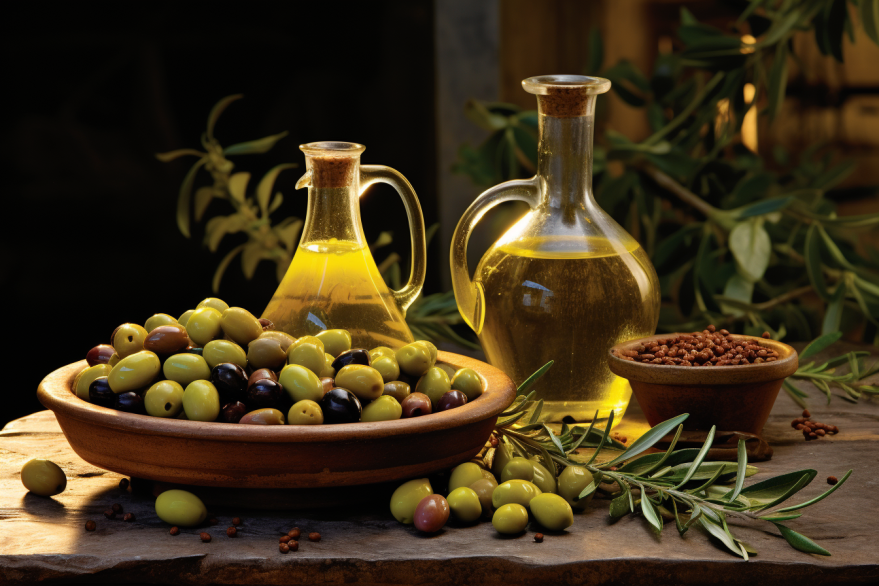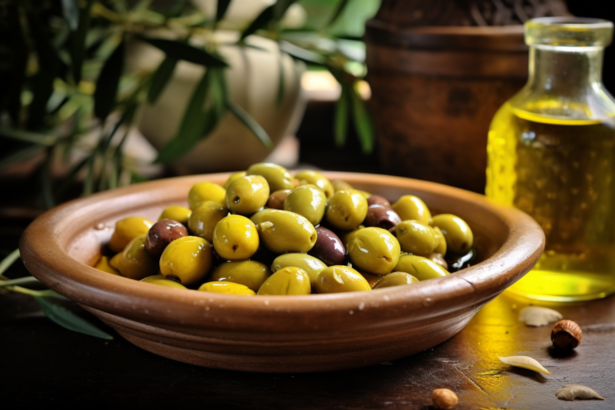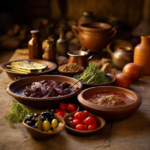Indulge your taste buds in the tantalizing world of Greek olives and olive oil, where exquisite flavors await. In this article, we will take you on a delightful journey through the rich culinary traditions of Greece, exploring the vibrant array of herbs and spices used in their cuisine. From the picturesque landscapes to the unique climatic conditions, discover how each region of Greece contributes to the unparalleled taste of their olives and olive oil. Get ready to savor the essence of Greece as we unravel the secrets behind this Mediterranean treasure.

History of Greek Olives
The ancient origins of olive cultivation
The cultivation of olives in Greece can be traced back thousands of years, with evidence suggesting that olive trees were first domesticated around 5,000 BCE. The Mediterranean climate of Greece, with its hot, dry summers and mild winters, provides the perfect conditions for olive trees to thrive. The ancient Greeks recognized the value of olives early on, not just as a food source, but also for their medicinal and cosmetic properties.
The significance of olive trees in Greek mythology
In Greek mythology, olive trees hold a significant place. According to legend, the goddess Athena competed with the sea god Poseidon to become the patron deity of the city-state of Athens. Athena struck the ground with her spear, and from it, an olive tree emerged. This act symbolized the gift of peace and abundance that olive trees brought to the people. The olive branch became a symbol of peace and harmony, often depicted in ancient Greek art and architecture.
The role of olives in ancient Greek culture
Olives and olive oil were integral parts of ancient Greek culture and cuisine. Olives were a staple food, enjoyed in various forms such as whole olives, olive oil, and even as a fermented paste called “elaiasmos.” Olive oil was widely used in cooking, as a dressing for salads, and as a fuel for lamps. Olive trees were considered sacred, and their importance extended beyond food and medicine. The Greeks believed that olive trees were gifts from the gods and played a vital role in religious ceremonies and rituals.
Types of Greek Olives
Kalamata olives
Kalamata olives, named after the city of Kalamata in the Peloponnese region of Greece, are one of the most well-known Greek olive varieties. These dark purple olives have a distinct almond shape and are prized for their rich, fruity flavor. Kalamata olives are often brine-cured to enhance their taste and are a popular ingredient in Greek salads, pasta dishes, and mezes.
Halkidiki olives
Halkidiki olives are large, oval-shaped olives grown in the Halkidiki region of northern Greece. These olives have a firm texture and a mild, buttery flavor. They are typically harvested when they are still green and are usually preserved in brine or marinated with herbs and spices. Halkidiki olives are often enjoyed as a part of an antipasto platter or as a garnish for cocktails.
Throuba olives
Throuba olives, also known as Tsakistes or Throumpa olives, are a specialty olive variety found on the island of Thassos.
These olives are harvested late in the season, allowing them to ripen on the tree until they reach a rich, dark purple color. Throuba olives have a unique sweet and fruity flavor, with a soft and meaty texture. They are typically sun-dried and then packed in olive oil, which enhances their natural sweetness.
Amfissa olives
Amfissa olives, named after the town of Amfissa in central Greece, are small to medium-sized olives with a deep purple or black color. These olives have a firm texture and a slightly bitter taste. Amfissa olives are often brine-cured or fermented and are commonly used in Greek cuisine, particularly in dishes like stews, casseroles, and bread.
The Olive Harvesting Process
When and how olives are harvested
Olive harvesting in Greece typically takes place from November to January, depending on the region and the variety of olives. Traditionally, olives were hand-picked from the trees using long sticks or rakes, which allowed the olives to fall into nets spread on the ground. However, modern methods have introduced the use of mechanical harvesters, which shake the olives loose from the branches.
Traditional methods vs modern techniques
While mechanical harvesting has become more common in recent years due to its efficiency, many Greek olive growers still prefer traditional hand-picking methods. Hand-picking helps prevent damage to the trees and ensures that only the ripest olives are selected. Additionally, some olive trees are located on steep slopes or in mountainous areas, where mechanical harvesters are not practical.
The importance of timing in olive harvesting
Timing is crucial in olive harvesting to ensure the highest quality of olives. Green olives, picked early in the season, are generally more bitter and have a firmer texture. As the olives mature and turn darker in color, they develop a richer flavor and a softer flesh. The ideal time for harvesting depends on the desired taste and purpose of the olives, whether for eating as a whole olive or for olive oil production.

Methods of Olive Oil Production
Cold-pressing
Cold-pressing is the traditional method of extracting olive oil from olives. The olives are crushed into a paste using stone mills, and then the paste is pressed to release the oil. Cold-pressing ensures that the oil retains its natural flavors and nutritional properties. This method is favored for producing high-quality extra virgin olive oil, known for its low acidity and exceptional taste.
Centrifugation
Centrifugation is a modern technique that speeds up the olive oil extraction process. After the olives are crushed, the paste is spun in a centrifuge, separating the oil from the solids and water. Centrifugation allows for a faster and more efficient extraction, resulting in higher yields of olive oil. However, some argue that this method may affect the flavor and quality of the oil compared to traditional cold-pressing.
Decantation
Decantation is a method used to separate the oil from any remaining water or solids after centrifugation. The oil is transferred to settling tanks, where it is left to naturally separate from the other components. The process of decantation helps remove any impurities and allows the oil to clarify further. This method is often used in combination with centrifugation for olive oil production.
Blending
Blending is a technique used to create olive oils with different flavor profiles and characteristics. Olive oils from different olive varieties, regions, or even harvest years can be blended together to achieve the desired taste. Blending allows producers to create unique combinations and balance the flavors of different olives. Additionally, blending can help maintain consistency and flavor profiles from year to year.
The Art of Olive Oil Tasting
The characteristics of high-quality olive oil
High-quality olive oil possesses several key characteristics that set it apart. Extra virgin olive oil, the highest grade of olive oil, should have a fruity and fresh aroma, with hints of grass, herbs, or even tropical fruits. It should have a well-rounded taste, with a balance of bitterness, pungency, and fruitiness. The texture should be smooth and velvety, leaving a pleasant mouthfeel.
The sensory experience of olive oil tasting
Olive oil tasting, also known as olive oil sensory evaluation, is an art that requires training and experience. To properly taste olive oil, it is essential to use a special tasting glass and follow a specific technique. Tasters evaluate the aroma, taste, and mouthfeel of the oil, noting any positive or negative attributes. Olive oil tasting can be a sensory adventure, allowing enthusiasts to appreciate the complexity and nuances of different oils.
Common flavor profiles and descriptors
Olive oils can have a wide range of flavor profiles and descriptors, depending on factors such as the olive variety, the region, and the processing methods. Some common flavor profiles include grassy, fruity, peppery, nutty, and buttery. Descriptors often used to describe olive oil include green, ripe, robust, delicate, and intense. Tasters also look for positive attributes such as harmony, complexity, and balance in the oil’s flavor and aroma.
Health Benefits of Greek Olives and Olive Oil
Rich in heart-healthy monounsaturated fats
Greek olives and olive oil are known for their high content of monounsaturated fats, particularly oleic acid. These fats have been linked to various health benefits, including reducing the risk of heart disease and improving overall heart health. Consuming olive oil as part of a balanced diet can help maintain healthy cholesterol levels and promote cardiovascular well-being.
Antioxidant properties
Greek olives and olive oil contain potent antioxidants, such as polyphenols and vitamin E. These antioxidants help protect the body’s cells from oxidative stress and free radical damage. Regular consumption of olive oil has been associated with reduced inflammation and a lower risk of chronic diseases, including certain types of cancer and neurodegenerative conditions.
Lowering cholesterol levels
The monounsaturated fats found in Greek olives and olive oil can help lower LDL (bad) cholesterol levels and increase HDL (good) cholesterol levels. This can contribute to a healthier lipid profile and may help reduce the risk of cardiovascular disease. The antioxidants present in olive oil also play a role in maintaining healthy cholesterol levels.
Reducing inflammation
Chronic inflammation is a common underlying factor in many diseases, including heart disease, diabetes, and arthritis. The polyphenols found in Greek olives and olive oil have anti-inflammatory properties and can help reduce inflammation in the body. Regular consumption of olive oil as part of an anti-inflammatory diet may help manage inflammatory conditions.
Promoting digestive health
Olive oil has long been used as a natural remedy for digestive issues. The healthy fats in Greek olives and olive oil can aid in digestion and promote the absorption of nutrients. Olive oil has a mild laxative effect and can help regulate bowel movements. Additionally, the polyphenols in olive oil have been shown to have a positive impact on gut bacteria, supporting a healthy digestive system.
Cooking with Greek Olive Oil
Using olive oil in traditional Greek recipes
Greek cuisine showcases the versatility and flavors of olive oil in a myriad of traditional dishes. From the iconic Greek salad, known as “Horiatiki,” to moussaka, spanakopita, and baklava, olive oil plays a central role in Greek cooking. It adds richness and depth of flavor to soups, stews, and roasted vegetables. Greek olive oil is also used to dress fresh seafood, drizzle over grilled meats, and finish off traditional dips like tzatziki and hummus.
Substituting butter or vegetable oil with olive oil
In addition to its unique taste, olive oil offers health benefits that make it a popular choice for substituting butter or vegetable oil in cooking. Olive oil can be used as a healthier alternative for sautéing, frying, and baking. It adds a subtle flavor and richness to dishes while reducing the saturated fat content. When substituting olive oil for butter, it is generally recommended to use a 3:4 ratio (3/4 cup of olive oil for every 1 cup of butter).
Enhancing the flavors of salads and vegetables
Greek olive oil is particularly well-suited for enhancing the flavors of salads and vegetables. A drizzle of extra virgin olive oil over a fresh salad brings out the vibrant colors and enhances the natural flavors of the ingredients. Olive oil can be used as a dressing on its own or mixed with vinegar or lemon juice. When roasting or grilling vegetables, a generous drizzle of olive oil adds richness and helps caramelize the vegetables, creating a delicious and healthy side dish.
Incorporating olive oil in baking
Olive oil can be a delightful addition to baked goods, adding moisture and a unique flavor profile. It is commonly used in traditional Greek desserts such as olive oil cake, melomakarona (honey-spice cookies), and kourabiedes (almond sugar cookies). Olive oil can also be used in bread-making, producing a tender crumb and a subtle fruity taste. When using olive oil in baking, it is recommended to choose a milder or fruitier oil to complement the flavors of the recipe.
Exploring the Regions of Greek Olive Production
The diverse olive-growing regions of Greece
Greece boasts a rich diversity of olive-growing regions, each with its own unique characteristics and olive varieties. The country’s main olive-growing regions include the Peloponnese, Crete, the Aegean islands, and mainland Greece. The regional variations in climate, soil, and altitude contribute to the distinct flavors and qualities of Greek olive oils.
Distinctive flavors and characteristics of regional olive oils
Olive oils from different Greek regions showcase a wide range of flavors and aromas. For example, olive oils from the Peloponnese are often described as robust and peppery, with a slight bitterness. Oils from Crete, on the other hand, are known for their complex and balanced flavors, combining fruitiness with grassy and herbal notes. The Aegean islands produce olive oils that are typically milder and more delicate in flavor.
Visiting olive groves and mills for a unique cultural experience
Exploring Greece’s olive-growing regions offers visitors a unique cultural experience, allowing them to witness firsthand the art of olive cultivation and oil production. Many olive groves and mills in Greece offer tours and tastings, where visitors can learn about the history and traditions of Greek olive farming. From the ancient olive trees in Crete to the picturesque olive groves of Kalamata, these experiences provide a deeper appreciation for Greek olives and olive oil.
Traditional Olive Oil Festivals in Greece
Celebrating the olive harvest in different regions
Olive oil festivals, known as “panigiria,” are an integral part of Greek culture and tradition. These festivals celebrate the olive harvest and the importance of olives and olive oil in Greek life. Throughout Greece, various regions hold their own unique festivals, featuring processions, traditional dances, live music, and, of course, an abundance of olive oil and olive-related products.
Participating in olive oil tastings and competitions
Olive oil tastings and competitions are often a highlight of olive oil festivals. Tasters and judges evaluate the quality of different olive oils, awarding prizes to the best oils in various categories. Visitors have the opportunity to sample a wide variety of Greek olive oils, discovering their unique flavors and characteristics. These tastings provide an educational experience and help to promote and preserve the heritage of Greek olive cultivation.
Enjoying traditional Greek music, dance, and food
Olive oil festivals in Greece are not just about olive oil; they are also vibrant celebrations of Greek culture and gastronomy. Traditional Greek music, dance performances, and folkloric costumes create a lively and festive atmosphere. Visitors can savor a variety of traditional Greek dishes, often prepared with locally sourced ingredients and, of course, plenty of Greek olives and olive oil. These festivals offer a wonderful opportunity to immerse oneself in the rich traditions and flavors of Greece.
Preserving Greek Olive Cultivation and Heritage
Sustainable farming practices
In recent years, there has been a growing focus on sustainable farming practices in Greek olive cultivation. Many Greek olive growers have adopted environmentally friendly methods such as organic farming, integrated pest management, and water conservation techniques. These practices help protect the soil, reduce the use of chemicals, and ensure the long-term sustainability of Greek olive farming.
Protecting ancient olive trees
Greece is home to ancient olive trees, some of which are believed to be thousands of years old. These irreplaceable trees hold cultural, historical, and ecological significance. Efforts are being made to protect and preserve these ancient olive trees, as they are an essential part of Greek heritage. Organizations and initiatives aim to raise awareness and provide support for the conservation and restoration of these precious living treasures.
Promoting Greek olive products in international markets
Greek olives and olive oil have gained a well-deserved reputation for their exceptional quality and distinctive flavors. To ensure the continued success of Greek olive products, efforts are being made to promote them in international markets. Greek olive oil producers participate in trade shows, food expos, and other events to showcase their products and establish relationships with buyers worldwide. The growing global demand for Greek olives and olive oil helps support Greek farmers and keeps the tradition of Greek olive cultivation alive.
In conclusion, Greek olives and olive oil are steeped in a rich history and cultural significance. From their ancient origins and mythological connections to their diverse varieties and traditional production methods, Greek olives and olive oil offer a unique and captivating culinary experience. Whether enjoyed as part of a Mediterranean diet, used in traditional Greek recipes, or savored during olive oil tastings and festivals, Greek olives and olive oil continue to captivate taste buds and preserve the heritage of Greece’s olive cultivation.
Sponsored by
Digital Marketing Company Digital Heroes Caffe and Financial Navigator 360.
Exploring the Exquisite Flavor of Greek Olives and Olive Oil: A Glimpse into Greece’s Liquid Gold
The allure of Greek cuisine often lies in its ageless traditions and the natural bounty of the land. Among these, Greek olives and olive oil stand as pillars of the culinary culture, offering a delectable journey through Greece’s rich gastronomic heritage. Through Chef on a Bike, we unveil the charm of these Greek emblems, enhancing the Greek Mezes Recipe, enriching the stuffing of Dolmades, and bringing a warm, hearty start to Greek Breakfast and Greek Mornings.
Guided by the skilled Anna-Maria Barouh, our platform is a sanctuary for those seeking to delve deeper into the heart of Greek culinary traditions.
FAQs on Greek Olives and Olive Oil
-
What makes Greek olives and olive oil unique?
- The unique climate and soil conditions of Greece contribute to the distinct flavor and high-quality of Greek olives and olive oil, often considered among the best globally.
-
How are Greek olives and olive oil used in traditional dishes?
- They are quintessential ingredients, used in everything from appetizers and salads to mains and even some desserts, adding a rich flavor and health benefits to Greek dishes.
-
What are the health benefits associated with Greek olives and olive oil?
- Rich in antioxidants and monounsaturated fats, they promote heart health, reduce inflammation, and are believed to have cancer-preventive properties.
-
Where can I purchase authentic Greek olives and olive oil?
- They can be purchased from specialty Greek stores, online, or even in local markets in Greece. Some online platforms also deliver authentic Greek products globally.
A Culinary Odyssey Beckons
Embark on a flavorful odyssey with Chef on a Bike, discovering the essence of Greek cuisine through its olives and olive oil. Our platform offers more than just recipes—it’s an invitation to a Greek culinary haven, rich in tradition and taste.
For a further exploration into Greek culinary wonders, visit Olive Tomato and My Greek Dish, portals dedicated to bringing the taste of Greece right to your kitchen.




















